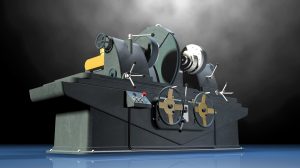
Lathes are used extensively in the manufacturing industry to remove material from a workpiece. Whether it’s made of wood or metal, most workpieces can be altered using a lathe. The workpiece is attached to the lathe, after which it rotates against a stationary cutting tool. Using these mechanics, lathes support a variety of machining processes.
#1) Cutting
If a manufacturing company needs to cut a significant amount of material off a workpiece, it may use a lathe. Cutting is a machining process that involves the separation of material from a workpiece, typically using a sharp cutting tool.
#2) Drilling
In addition to cutting, lathes can also drill holes into workpieces. For drilling, the lathe is equipped with a special drill bit. As the drill bit presses against the workpiece, it digs a circular cross-section hole that’s able to support screws, bolts and other common types of fasteners.
#3) Sanding
Lathes are frequently used to finish workpieces via sanding. For sanding, the lathe uses a tool bit equipped with an abrasive material, such as sandpaper. As the workpiece rotates against the abrasive material, it creates a smooth and uniform surface by removing small amounts of material.
#4) Knurling
Another common machining processes supported by lathes is knurling. What is knurling exactly? Knurling refers to a machining process that involves the creation of a patterned and textured surface on a workpiece using a roller. The roller features many raised spikes that, when exposed to a workpiece, pierce holes into the surface of the workpiece.
#5) Deformation
Of course, lathes are fully capable of deforming workpieces as well. Deformation is a machining process that’s used to change the shape of a workpiece. The workpiece is physically altered to achieve a different shape. Lathes are highly effective at deformation because of their ability to easily remove material from workpieces, resulting in a different shape for the workpiece.
#6) Turning
Many manufacturing companies use lathes to perform turning on workpieces. Not to be confused with milling, turning involves the use of a stationary cutting tool to remove material from a rotating workpiece. It’s called “turning” because the workpiece “turns” against the lathe’s cutting tool.
#7) Facing
Finally, lathes support facing operations. It’s a common machining process that’s used to cut the surface of a workpiece. The facing tool is secured to a mounting system on the lathe. Once in place, the facing tool will press against the workpiece to cut away a uniform amount of material from its surface.
